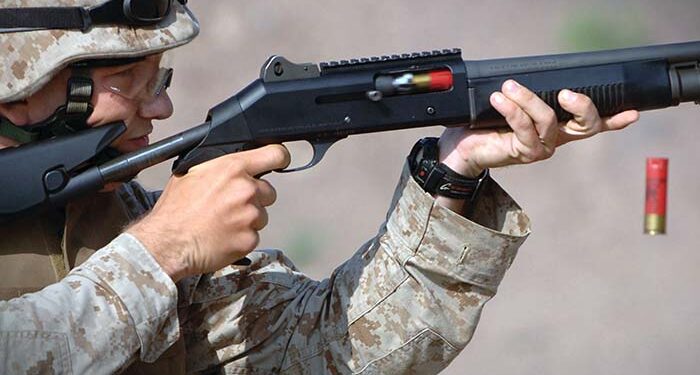By Christopher R. Bartocci –
On the battlefield, many people never even give thought to the shotgun. One expects to see modern assault rifles and belt fed machineguns.
However, the shotgun has always been part of the arsenal. They have served in every war this nation has ever been in. From the trenches of World War II to the underground tunnels in Vietnam they were used. The shotgun is a devastating weapon at close range to say the least. With buckshot, the shotgun is devastating up close to a target. Although even with a slug range is limited to 100 yards, but the destructive power and penetration of the slug is undeniable. Throughout the last century, the shotgun has been 12 gauge and pump action. As of this writing, the main combat shotgun for the US military is the Mossberg 500/590 series shotguns. This is a 12 gauge slide action shotgun with a 20 inch barrel and a 8 round tube. The shotgun has a heat shield as well as the ability to accept a bayonet. Different barrel lengths are available as well including 14 and 20 inch variations. The stock, handguard as well as the trigger housing are manufactured out of polymer. This shotgun has served in Operations Desert Storm, Iraqi Freedom and Enduring Freedom. On May 4, 1998, a solicitation (DAAE30-98-R-0401) was issued to Picatinny arsenal for a new shotgun. This was a much more modernized semi-automatic combat shotgun.
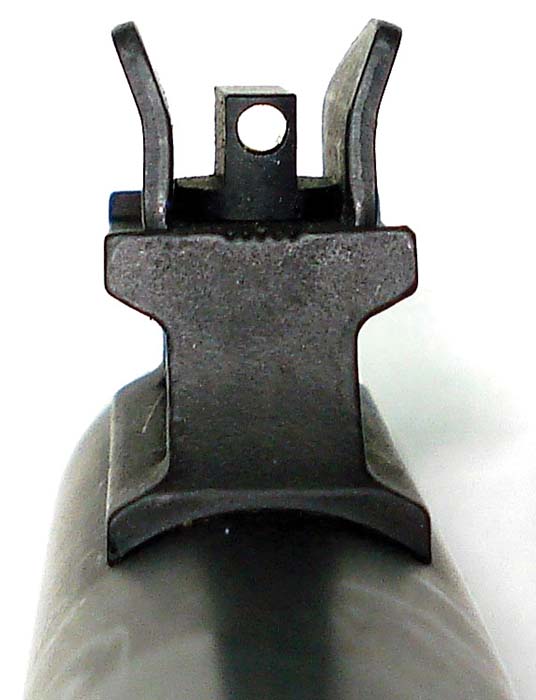
The requirements put out were that the shotgun must fire 2.75-inch 12 gauge slugs (100 to 125 meters accurately) and 00 Buckshot (40 meters accuracy). The shotgun must have a length up to 41.75 inches and be capable of reconfiguring to 36 inches or less. The maximum weight allowed was 8.5 pounds with the desire to be six pounds unloaded. The shotgun will be equipped with Low Light Level iron sights and standard Mil-Std-1913 rail on the top of the receiver to permit use of enhanced sighting systems. The project was called the Joint Services Combat Shotgun (JSCS) and the weapon would go on to be classified as the M1014.
The purpose of the shotgun would be for use by all branches of the military for all types of missions including security/interior guard operations, rear area security operations, guarding prisoners of war, raids, ambushes, urban combat and whatever else may come along.
Benelli SpA is an Italian company located in Urbino, Italy. The company was founded in 1967 and its key products have always been high quality shotguns although it began life as a motorcycle factory that sold their motorcycles through Montgomery Ward. They produce hunting, competitions and military/law enforcement shotguns for customers throughout the world. Benelli became noted for their M3 12 gauge. This shotgun became famous in law enforcement circles due to it being both semi-automatic and pump. If the officer needed to switch to less lethal ammunition they could be cycled by using pump action and when using normal ammunition the shotgun would be in the semi-automatic mode of fire. In 2000, Benelli SpA and Benelli USA were purchased by Beretta.
Benelli Armi S.P.A. of Urbino Italy submitted their Benelli M4 Super 90 Combat Shotgun for the trials.
Benelli is most known for their employment of inertia recoil system. This eliminated any gas operation components thus decreased weight. Since no gas was used to cycle the action the shotgun ran rather clean. It also is one of the the fastest cycling shotgun in the industry. Benelli normally chrome plates bores and chambers. The shotgun can fire upwards of 25,000 rounds without failure of any major components. Also they normally chrome plate the bolt. They manufactured both military/Law Enforcement as well as commercial versions of the shotgun. They manufacture models suitable for any task. The first version was called the M1 Super 90.
On August 4, 1998, Benelli sent 5 shotguns for testing to Aberdeen Proving Grounds. Benelli beat all of the competition. The M1014 Joint Services Combat Shotgun was awarded to Benelli contracted by Heckler & Koch which was at that time the importer for the Benelli shotgun. The first 20,000 shotguns were delivered to the Marine Corps. The M1014 shotgun was given National Stock Number: 1005-01-472-3147.

The M4 is quite unique compared to those shotguns that came before it. This was the first shotgun Benelli had ever made that did not use the inertia operating system. Instead they opted for a piston operated mechanism. This mechanism is called ARGO or Auto Regulating Gas Operated system. This consists of two short stroke operating rods using two stainless steel pistons which are touted as being self-cleaning. The operating mechanism is located just in front of the chamber to function opposite of the bolt. The ARGO system uses only four components which are two symmetrical shrouds containing two small steel gas pistons. The ARGO gas system eliminates the complexities in using a standard piston mechanism with all its additional parts. The ARGO system is self regulating which will allow the shotgun to function with a wide array of shotgun ammunition. The bolt itself, is a rotary lock mechanism. The bolt runs in a cam track to lock and unlock. The bolt is also chrome plated. The ARGO operating system makes it possible to fire a wide variety of ammunition. The specification called for 2.75 inch shot shells but the Benelli shotgun will also fire 3 inch shells as well.
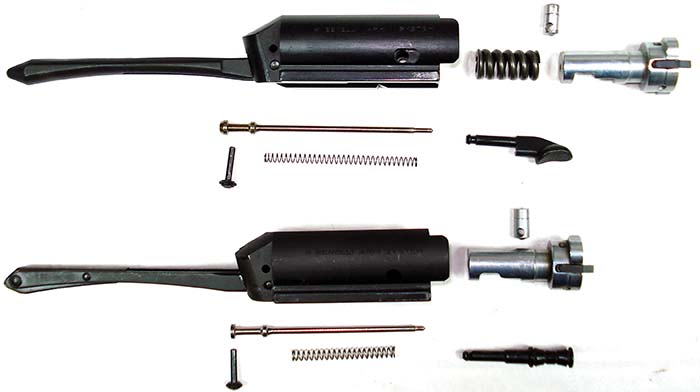
The only drawback to the system is that less than lethal ammunition including rubber pellets is that the action must be cycled manually. There were proponents during testing that felt a combination semi as well as bolt would have been a better option due to an increased use of less than lethal ammunition in peace keeping missions. There is no doubt that making a shotgun in dual operating system would complicate the design and may just well compromise the combat reliability demanded of the shotgun. Another reason for the switch from inertia to ARGO system was so the shotgun would remain reliable with additional auxiliary equipment such as optics.
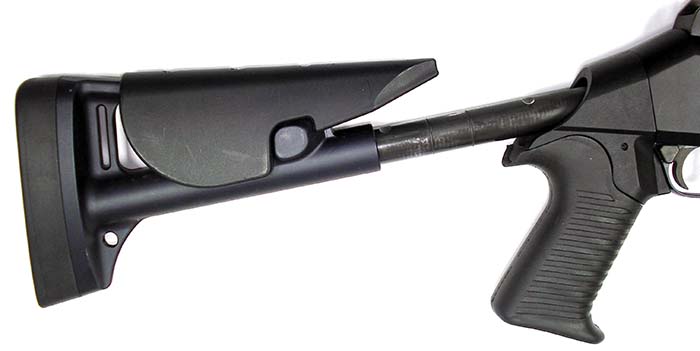
The barrel is 18.5 inches in length and uses an improved cylinder fixed choke to accommodate the slug and buckshot loads it is required to use. Many of the barrels are fixed with this improved cylinder choke but they are also found with removable chokes. The shotgun provided for test and evaluation utilizes a removable choke. This certainly adds to the adaptability of the shotgun. Rifled choke tubes are available for slugs (sabot) which increase range and accuracy. The entire bore and chamber are chrome plated.
The ammo tube holds 7 rounds of 2.75 inch shotgun shells. The shotgun is actually capable of carrying 9 shells. There are 7 in the tube, one in the chamber and one under the carrier. With practice this is quite easy to do. Commercial versions use an adapter which only permits 5 shells.
The stock is a large part of the modularity of the shotgun. The stock has two positions allowing not only for adjustment for smaller statured individuals but to those wearing body armor. To move you will depress the catch button on the left side, give it a quarter turn clockwise and pull to the rear. Once the stock is in the desired location rotate a quarter turn counter clockwise and the stock is locked in position. Without tools the stock and pistol grip can be reconfigured to a fixed or telescopic stock. There are numerous accessories available for this shotgun as well. The safety of the shotgun is a conventional cross bolt safety located at the rear of the trigger guard. The right side has a larger button for easy manipulation even when using gloves. The sights on the shotgun are quite nice. They are a ghost ring sight similar to that one would use on a M16-type or M4 carbine. The sights are adjusted by the rim of a shotgun shell. In front of the rear sight is a segment of Mil-Std-1913 which will permit any optic to be attached. The Aimpoint Comp4 and the Trijicon reflex sight are ideal for this short range weapon
All of the shotguns steel components are matte black/grey phosphate corrosion resistant finish while the aluminum components are hard coat anodized black. The inside of the bore and chamber as well as the bolt are hard chrome plated. The shotgun has a weight of 8.42 pounds. Due to the design, the Benelli shotgun requires little maintenance, even in harsher environments.
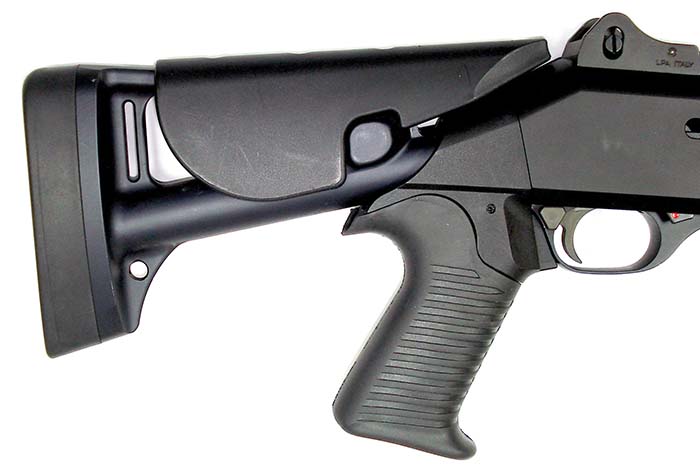
The shotgun loads different than most any other. There are two different ways to load. The first in to insert all 7 shells into the tube. Then you would depress the carrier button and a shell will be released to under the carrier. Then you would simply pull the bolt back and release to load that shell into the chamber. The other way is to pull the bolt back to the rear, insert a shell into the chamber and then flip the rifle over and load the tube with 7 shells. The way the shotgun functions makes it easy under a tactical situation to swap out the round in the chamber if need be. for example you are firing buck shot and the target is hidden behind a barrier. All you have to do is pull the bolt to the rear, eject the shell in the chamber, drop your slug in the chamber and let the bolt go. The shell in the tube is not released unless the shotgun is fired or the shooter manually hits the carrier button releasing it.
Field stripping the shotgun is easy and requires no special tools, in fact no tools at all. First step is to ensure the shotgun is clear and there are no shells in the tube or chamber. Depress the carrier button and pull the bolt back until it locks to the rear. Unscrew the forend cap counterclockwise and remove. Bush the barrel forward until the two handguard half’s come loose and remove them. Now you grasp the barrel and pull the barrel out of the receiver. Depress the carrier button and allow the bolt to go forward. Twist and pull the cocking lever out of the bolt and slide the bolt assembly out of the front of the receiver. Remove the firing pin retainer pin from the right side of the bolt carrier. Remove the firing pin and firing pin spring from the rear of the bolt carrier. Lift the locking head pin out of the top of the bolt carrier and now you can remove the bolt from the carrier by pulling the bolt out of the carrier. To remove the trigger group, grasp the cocking lever, use the tip to push inward on the trigger pin from the right side of the receiver. Pull the pin outward until it stops to detent. Now pull downward and remove the trigger assembly. To remove the gas pistons from the barrel, use the tip of the cocking lever, insert it into the groove on the gas cylinder plugs and rotate counter clock wise and remove. Remove the gas piston from the cylinder.

Although not done routinely, if you wish to remove the stock and pistol grip you would do as follows, depress the stock locking pin and rotate the stock clockwise and push it inward until the line marked on the recoil tube. Now rotate the stock counterclockwise and pull the stock off of the recoil tube. Now grasp the pistol grip and unscrew counterclockwise and remove.
The test and evaluation shotgun received by SAR was exactly what one would come to expect from Benelli. Flawless fit and finish. When the bolt was actuated it was just as smooth as could be. It is certainly different for someone who is use to a Remington 870 or any other pump or auto loading shotgun. The loading procedure was the same. The ability to change out shells with different type in an emergency is easier on the Benelli than any other shotgun this author has tested. It is clear why Benelli shotguns are popular among competitors. The time saved when transitioning from buckshot to slug is significant. There is no need to remove two shells (one in the chamber and the one released from the magazine), you only eject the chambered round and drop it in place.
The ammunition tested was provided by both Federal and Remington. There were 25 rounds of Remington 2 3/4 inch OO Buckshot (12SB00) and 25 rounds of Federal Premium 2 3/4 inch OO Buckshot (P15400). There were also 20 rounds of Remington Slugger 2 3/4 inch 1 oz slugs (SP12SMag-RS-5PK) and 20 rounds of Winchester Super X 2 3/4 1 oz hollow point slugs (X12RS15). Both of these loads are in use with local Police and SWAT teams in the upstate New York area.
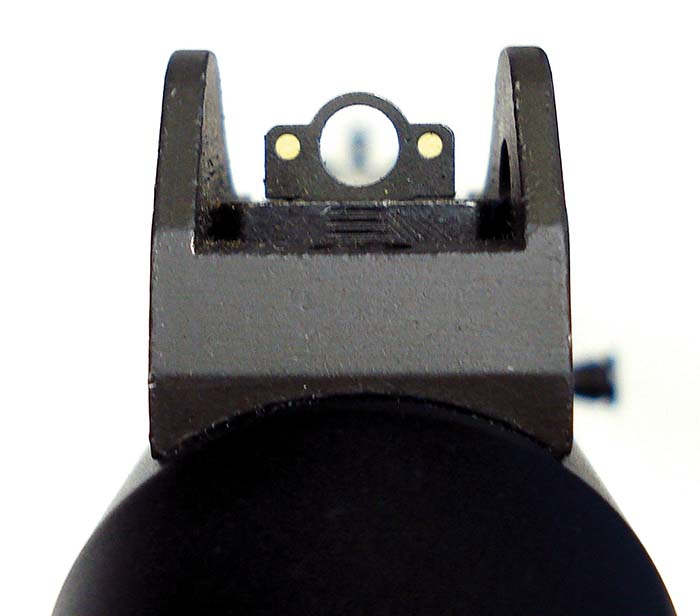
The only thing added to this shotgun for testing was an optic. The optic chosen is the Trijicon Reflex sight (RX34A-51). This has a wider screed (42mm) compared to the SOPMOD (24mm) optic. There is a honey comb diffuser to prevent glare off the lens and giving away the shooter’s position. Due to the larger screen, the optic has a Mount Surface to Optical Axis of 1.506 inches. This does not allow for co-witnessing with iron sights. The sight has a 4.5 MOA amber dot which is powered by both a tritium lamp as well as fiber optics. This adjusts the brightness of the dot to the light conditions in the environment. The sight is used with both eyes open. The sight weighs 8.2 oz without the mount. Due to the limited range of the shotgun, this would be an ideal option for an optic.
The T&E shotgun was found to have the fit and finish one would come to expect from Benelli. The finish was immaculate. The bolt when retracted was as smooth as can be. The bolt retracts with little effort compared to many of the semi-automatic shotguns found on the market. When fired without the optic, this author appreciated the sight picture. Since much of my work is with M16/AR15-type weapons, familiarity of the sights picture was greatly appreciated. When the shotgun is brought to the shoulder the sight picture is quickly obtained. When the Trijicon Reflex sight was added, that was a whole new level of quick sight acquisition. Drawing the shotgun up and leaving both eyes open, it was easier to get off very quick follow-up shots. This shotgun and Trijicon are an excellent tactical pairing. With the action as it is, it is very easy to get off quick shots. Ideal for urban conditions as well as ambush situations under close quarter battles. Reliability is again what one would expect from Benelli, absolutely flawless. During the testing, there was a police recruit shotgun course training. The department issues Remington 870 slide action shotguns. Several of the students who did well as well as some who did poorly right out of the gate were given the Benelli M4 to run through the same course. They all improved with the semi-automatic M4. They stayed on target better due to not having to pump the action on the shotgun. This author also really appreciates the ease of transitioning from OO Buckshot to slug. This really is second to none. To transition with the 870, you have to eject the empty, pull or shake the round released from the tube and then insert the slug. The M4, you simply pull rearward on the bolt, eject that chambered round and drop the slug into the receiver and let the bolt go. But realistically, no matter how much better the M4/M1014 system is the cost will always keep it out of reach of the normal rank and file police. This gun is mainly used by SWAT due to the better budget and their ability to get better weapons. The telescopic stock does assist a great deal, but the shotgun is still long. The shorter NFA barrel is more appropriate for getting in and out of the car but you lose the higher capacity ammunition tube.

The Law Enforcement community is offered the M1014 but in a slightly modified design and it is known as simply the M4LE. There are two main differences between the military and law enforcement variations. First is the barrel. Instead of having a fixed improved cylinder choke, the barrel has removable choke tubes giving the officer more flexibility on ammunition. Also a rifled choke tube is available to allow for use with longer range sabot slugs. The second difference is in the stock assembly. On the M1014, the stock has but two positions, the M4LE has three positions.
After over 20 years of service, the Benelli M1014 is still the state-of-the-art in combat shotgun technology. The shotgun offers a soldier devastating firepower in a close quarter battle. The utter reliability of the system is second to none. It would be safe to say that the M1014 is the first widely adopted semi-auto combat shotgun in the world. It is used by many countries, in particular Special Forces in countries such as Brazil, Croatia, Georgia, Greece, Italy (of course!), Ireland, Israel, Lithuania, Moldova, UK, South Korea and the United States. There are large unknown numbers of police and SWAT teams that use the Benelli M4 or the inertia fired cousins. The Benelli M4 (M1014) is not a cheap shotgun, with an MSRP of $1899 or higher. You do get what you pay for a combat shotgun that you can bet your life on.
| This article first appeared in Small Arms Review V21N3 (April 2017) |



